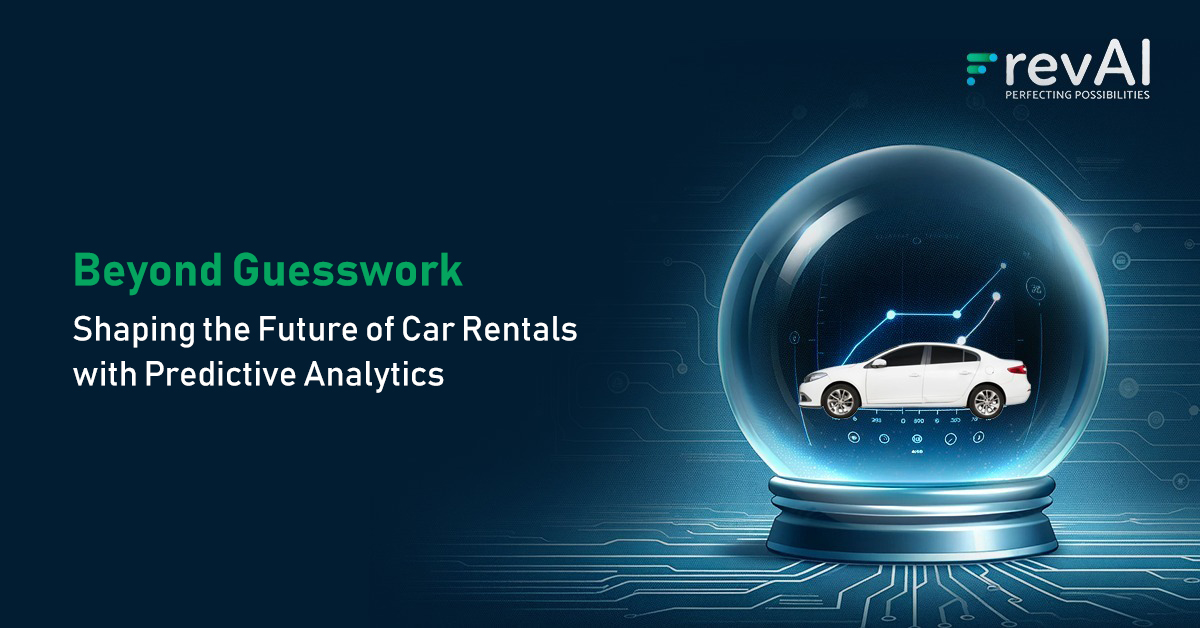01 Mar

Beyond Guesswork: Shaping the Future of Car Rentals with Predictive Analytics
Car rental businesses, across the globe, navigate a dynamic and ever-changing landscape in many spheres of their business.
Amid changing consumer preferences, tough competition, market shifts, technological advancements, and the emergence of new mobility options, dealing with uncertainty has become a standard part of business operations.
As a car rental business owner, you frequently pose these critical questions to your team: How can I accurately forecast demand? How do I effectively manage inventory for future requirements? What pricing strategy ensures customer satisfaction and maximizes profits? How does my competitor’s pricing affect my business?
The complexities presented by these challenges are enough to overwhelm anyone.
Traditionally, businesses have depended on historical data, manual analysis, and human intuition to tackle these challenges. However, these methods frequently fall short of providing real-time insights and can be subject to biases or incomplete information.
But today, navigating the ever-changing car rental landscape requires agility and innovation. How can car rental businesses leverage data analytics and new technologies to gain insights, optimize operations, and thrive in an uncertain future?
Predictive Analytics – The Game Changer
Harvard Business School defines predictive analytics as “the use of data to predict future trends and events. It uses historical data to forecast potential scenarios that can help drive strategic decisions.” (Source – https://online.hbs.edu/blog/post/predictive-analytics)
In simple words, Predictive analytics is a concept that enables businesses to ditch guesswork and leverage data for data-driven decisions.
For a car rental company, adopting data-driven decision-making means scrutinizing past rental patterns, customer demographics, market trends, and external influences like local events, hotel and flight bookings. This comprehensive analysis aids in developing optimal pricing strategies, accurately forecasting demand, understanding customer behavior, and pinpointing opportunities for operational improvement.
To comprehend the power of predictive analytics in steering businesses through uncertainty, it’s essential to delve into the specifics of what predictive analytics entails.
The Inner Workings of Predictive Analytics
1. Defining the Problem:
The initial step in the process of applying “Data Analysis” starts by asking a fundamental question: “What is the main problem we want to solve?”
Once we have the problem nailed down, it’s crucial to pinpoint the key variables that will enhance the predictions. Elements like Pricing History, Fleet Information, Customer Demographics, and Fuel Prices act as the foundational components of predictive models. These variables supply vital information to the analytics model, significantly improving its predictive accuracy. Ultimately, the goal is to lay the groundwork for developing accurate predictive models.
2. Data Gathering:
The next step is to understand the dataset used for making these predictions. Every business collects lots of useful data that can help in understanding customers, how the business works, and its detailed aspects. Here are the main types of data:
Internal data: This covers things like past bookings, information about the fleet, pricing history, who the customers are, and how the operations run.
External data: Adding in external data, such as weather forecasts, schedules of events, bookings for flights and hotels, economic trends, and fuel prices, gives a fuller picture of the market. This helps in spotting important factors and making smarter choices.
The main problem is that data is often spread out across different parts of a company, which makes it hard to get to and use. But, when this data is brought together, it creates a complete view of the customers, known as Customer 360, which helps in making decisions that are focused on the customer.
3. Data Analysis:
After consolidating the data in one location, the next phase involves leveraging it for decision-making. Here are some methods analysts use to derive insights and make informed choices:
Statistical analysis: It involves applying different mathematical techniques to examine historical data and uncover underlying patterns and trends. By analyzing large datasets, statisticians can identify correlations and relationships between variables. For example, statistical analysis might reveal that there’s a significant increase in car rentals when it rains. This insight helps businesses understand how external factors influence customer behavior and make informed decisions, such as adjusting pricing or marketing strategies accordingly.
Machine Learning: It is a type of technology that helps computers learn from data without being explicitly programmed. In the car rental business, it’s like having a smart car rental system that looks at various data points & scenarios to figure out patterns. For example: The system learns that car rentals increase during rainy weather. With more data, it improves predictions, helping the rental company anticipate demand spikes. So, if it rains again, the system adjusts inventory to meet customer needs, optimizing operations and enhancing satisfaction.
But the journey doesn’t end here! Analyzing the data and identifying patterns is only half the battle. While the output or analysis may be readily available thanks to data analysis, interpreting it correctly can still be challenging without additional context or understanding.
Businesses often need help interpreting and effectively leveraging these insights to their advantage. This lays the groundwork for exploring how businesses can extract value from the final output.
Turning insights into actionable recommendations
While predictive analytics offers valuable insights, the true business value comes from translating those insights into actionable recommendations. This is where Business Intelligence (BI) plays a crucial role, bridging the gap between data and decision-making.
BI tools distill complex data into accessible reports, charts, and dashboards, empowering business users – like revenue managers – to easily digest key insights:
- Demand forecasts: Anticipate rental needs at specific locations and adjust fleet allocation accordingly.
- Price recommendations: Optimize pricing strategies to maximize revenue while considering demand and competitor offerings.
- Customer preferences: Identify popular car models and tailor promotions or incentives based on customer segments.
- Increase operational efficiency: Reduce idle vehicles and optimize resource allocation.
- Boost revenue: Set competitive pricing and target the right customers with relevant offers.
- Enhance customer satisfaction: Offer a seamless rental experience based on anticipated needs.
As the bridge between insightful analytics and actionable strategies, BI tools not only highlight opportunities but also guide car rental businesses in applying these insights effectively. Whether it’s optimizing pricing, forecasting demand, or enhancing customer satisfaction, the translation of data into action is what ultimately drives success.
Suggested Read: AI for Car Rental Revenue Management
Drive Your Car Rental Business to Success with Data Analytics
So, if you are a car rental business Facing unpredictable bookings, stiff competition, and evolving customer needs in your car rental business? Data analytics might just be the key to unlocking your success.
Let’s delve into these challenges and explore how data analytics can provide solutions:
Challenge 1: Dip in Demand
Wondering why there are fewer visitors, both tourists and business travelers, coming to you?
Dive into your booking data and local event trends using analytics. Discover insights that could reveal untapped opportunities, such as serving local businesses in need of short-term vehicle rentals. Use these analytics-driven insights to expand your services and target new customer segments, revitalizing your business.
Challenge 2: Price Wars and Volatile Competition
Feeling lost in the pricing game?
Don’t play catch-up with competitors. Instead, leverage real-time competitor data and predictive models. Find the sweet spot for pricing that stays competitive while protecting your profits. Data-driven pricing ensures you never miss out on revenue while maintaining healthy margins.
Challenge 3: Navigating Seasonal Shifts
Forecasting busy seasons and adapting inventory accordingly can be uncertain.
However, analyzing historical data and local events can unveil useful patterns. Recognize increases in demand linked to holidays or events. Use this insight to make informed inventory choices and tailor marketing campaigns for maximum impact during peak times.
Challenge 4: Adapting to Shifting Customer Preferences
Wondering if minivans are still popular or if luxury cars are the new trend?
Analyze booking data to uncover emerging patterns. Determine if families or solo business travelers are your main customers. Use this information to adjust your vehicle selection, offering a variety of SUVs, compact cars, or luxury options to appeal to different types of customers and keep them coming back.
Remember: Data analytics isn’t magic, but it’s a powerful tool for turning guesswork into informed decisions. Use it to navigate industry challenges, optimize your business, and stay ahead of the curve. By embracing data-driven insights, you can transform your car rental business from simply reacting to market forces to proactively shaping its future.
Enhancing Your Data Strategy: Insightful Support with RevAI
Now that you understand the role of predictive analytics in car rentals, here’s some food for thought:
‘How do you elevate Your Strategy with Data?’
Consider RevAI as a subtle yet powerful ally on your journey toward data-driven decision-making. Our suite of tools is designed to seamlessly integrate with your operations, providing:
- Competitive Intelligence, which enables the business to keep an eye over their competitor’s prices
- Price Visualization, a dashboard that transforms complex numbers into clear, actionable insights
- Rate Update, helps you do away with manual price changes. Use automation to update your prices based on market demand and competitor strategies.
- RevAI uses its brainy predictive analytics to give you super-smart insights.
RevAI isn’t just a tool; it’s a partner in refining your approach to car rental management, subtly enhancing your capabilities and helping you navigate the future with data at your helm.



